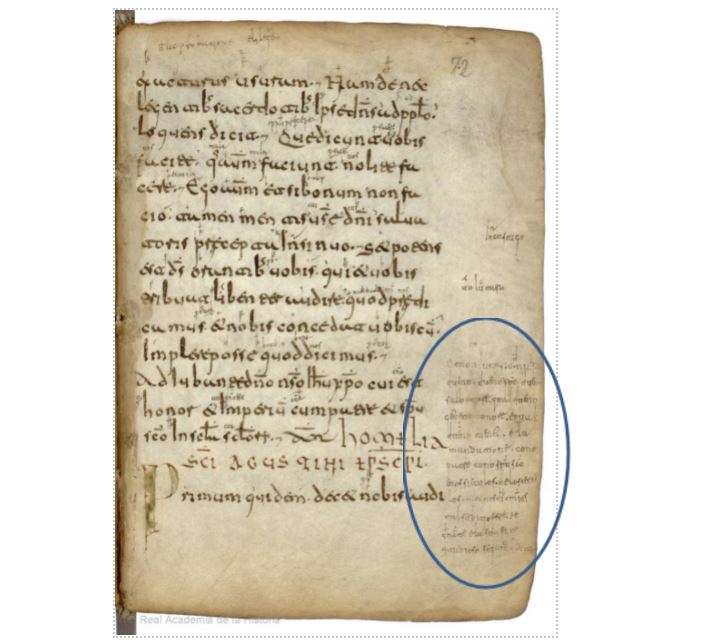All of the texts except for one are works of literature written by authors from different eras and origins. More information about them and the corresponding transcripts can be found below.
The middle ages - Glosa emilianense
One of the earliest written examples of a form of Romance similar to Spanish can be found in the notes that a monk wrote in the margins of a religious text in Latin. These notes (glosses) are known as the Glosas Emilianenses and are written in three different languages: 1) a simplified version of Latin; 2) a medieval form of a Hispanic Romance language; 3) Basque. The picture shows the longest annotation kept, known as Glosa 89.
 Glosa emilianense, Codice 60, folio 72r, manuscript kept at the Real Academia de la Historia.
Glosa emilianense, Codice 60, folio 72r, manuscript kept at the Real Academia de la Historia.
Libro de buen amor
Listen to a passage from El libro de buen amor (The Book of Good Love), written in 1330 by Juan Ruiz, Arcipreste de Hita (c. 1283–c. 1350), considered one of the masterpieces of Spanish poetry. It is a pseudo-autobiographical account about the love affairs of his author, told as fables and short stories representing all layers of Spanish medieval society. This extract tells us about the boy who wanted to marry three girls.
The Renaissance - Libro de la vida
Saint Teresa of Jesus (1515-1582) is one of the most prominent Spanish mystics, who aimed at reforming the Spanish Church and expressed their spirituality in writing. Their texts have a strong influence in what are considered the Golden Ages of Spanish Literature. Listen to this extract from Libro de la Vida (1565), her first book, her autobiography. Here she tells us about her first months in the monastery, where she originally is taken without much vocation, and how she starts changing her mind by speaking to another more experienced nun.
El Quijote
“En un lugar de la Mancha, de cuyo nombre no quiero acordarme…” (“Somewhere in La Mancha, in a place whose name I do not care to remember”) is one of the most famous first lines in Spanish literature. It belongs to El ingenioso hidalgo don Quijote de la Mancha (1605 and 1615), by Miguel de Cervantes (1547-1616), considered one of the best novels ever written and the founder of European modern novel as a genre. The book tells us the story of Alonso Quijano, a noble who, after reading so many chivalric romances, decides to become a knight-errant to fight injustice. In this extract, he tells us his reaction after seeing a monkey (who belongs to a comedian) performing some tricks.
The Golden Age - Amor constante más allá de la muerte
The Spanish Golden Age is a period where Spanish literature flourished, jointly with other artistic expressions. Francisco de Quevedo (1580-1645) is one of its main representatives. Among his literary works, his poems are well-known for a very concise use of language, a style known as conceptismo, as opposed to culteranismo, represented by his literary enemy Luis de Góngora (1561-1627).
The 18th-19th centuries - Aves sin nido
Peruvian writer Clorinda Matto de Turner (1852-1909) is considered one of the precursors of Latin American novel, also inspiring many women, through her work and her interest in improving women’s education. Her work Aves sin nido (Birds without nest) claims against how indigenous men and women were treated as slaves. This extract tells us about the relief of a family whose debts have been condoned.
The 20th-21st centuries - Cien años de soledad
Spanish literature is filled up with prominent writers from the 20th and 21st centuries. Among them, novels and short stories written by Colombian Gabriel García Márquez (1927-2014), winner of the Nobel Prize in 1982, are admired as prominent examples of one of the most influential genres of 20th-century literature, magic realism. Translated into more than 35 languages, his novel One hundred years of solitudine (1967) has sold more than 30 million copies worldwide. Listen to its famous beginning.
Las siete cabritas
French-born Mexican author Elena Poniatowska (1932) writes about social and political issues and has received numerous prizes and awards across the world for her works. This fragment belongs to Las siete cabritas (The seven kids), devoted to the lives of seven Mexican women, of which only Frida Kalho is well known globally.





Rate and Review
Rate this audio
Review this audio
Log into OpenLearn to leave reviews and join in the conversation.
Audio reviews